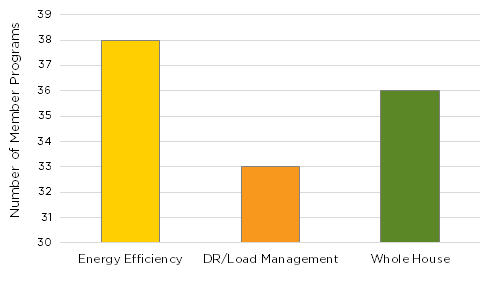

Connected thermostats provide an opportunity to deliver energy savings through equipment control, provide value to the grid as a load management resource, enable data-driven program evaluation, and engage customers in support of behavioral change. The number of CEE members promoting these products and services has grown significantly over the past five years and continues to be an area of significant interest within residential portfolios.

Due to the diversity of CEE members and their operating environments, program administrators are seeking to pursue connected thermostat offerings for myriad purposes. These purposes can range from enabling energy savings from ongoing HVAC operations to promoting connected thermostats as a deemed measure or a measure based on performance, managing peak energy consumption (or other balancing challenges) collecting data that may lead to greater energy savings or program participation, or better engaging with customers.
| The global thermostat market is projected to increase $2.3 billion in value from 2017-20233 |  |
With a proliferation of products now on the market and programs supporting these devices, CEE members worked with industry partners to develop an overview of strategies that are documented to realize savings from connected thermostats.
| The CEESM Connected Thermostats Program Guide is designed to support program administrators in the design and delivery of effective connected thermostat efforts that serve a broad range of portfolio objectives and inform industry partners of common member considerations. It synthesizes aspects of connected thermostat programs that are most likely to result in credible savings. This timely document summarizes the collective memberships’ recommended strategies to achieve efficiency, load management, and behavioral goals given the landscape of products and capabilities available in the market today. |
Having a shared strategy to approach program needs works to reduce customer confusion, diffentiate efficienct products, and enhance consumer satisfaction through common definitions, background data, and consensus program recommendations. |
Spanning a wide range of program objectives and member needs, this Program Guide serves to achieve the following objectives:
The Program Guide identifies recommendations for achieving benefits in the following four categories, through shared definitions and components that can be applied by any member across the United States and Canada:
For more information, contact Senior Program Manager Alice Rosenberg
1
Data collected from CEE Appliance Program Summaries, Connected Program
Summaries, Behavior Program Summaries, Existing Homes Program Summaries,
HVAC Program Summaries, and ETC Catalog of Assessments. Some member
organizations had more than one program or pilot in a given year.
2 US EPA estimates that ENERGY STAR
certified connected thermostats yield an average of 8 percent heating
and cooling energy savings per household.
3 https://www.researchandmarkets.com/research/ktf3df/smart_thermostat?w=5
About CEE
CEE is an award-winning consortium of
efficiency program administrators from the United States and Canada.
Members work to unify program approaches across jurisdictions to
increase the success of efficiency in markets. By joining forces at CEE,
individual electric and gas efficiency programs are able to partner not
only with each other, but also with other industries, trade
associations, and government agencies. Working together, administrators
leverage the effect of their ratepayer funding, exchange information on
successful practices and, by doing so, achieve greater energy efficiency
for the public good.